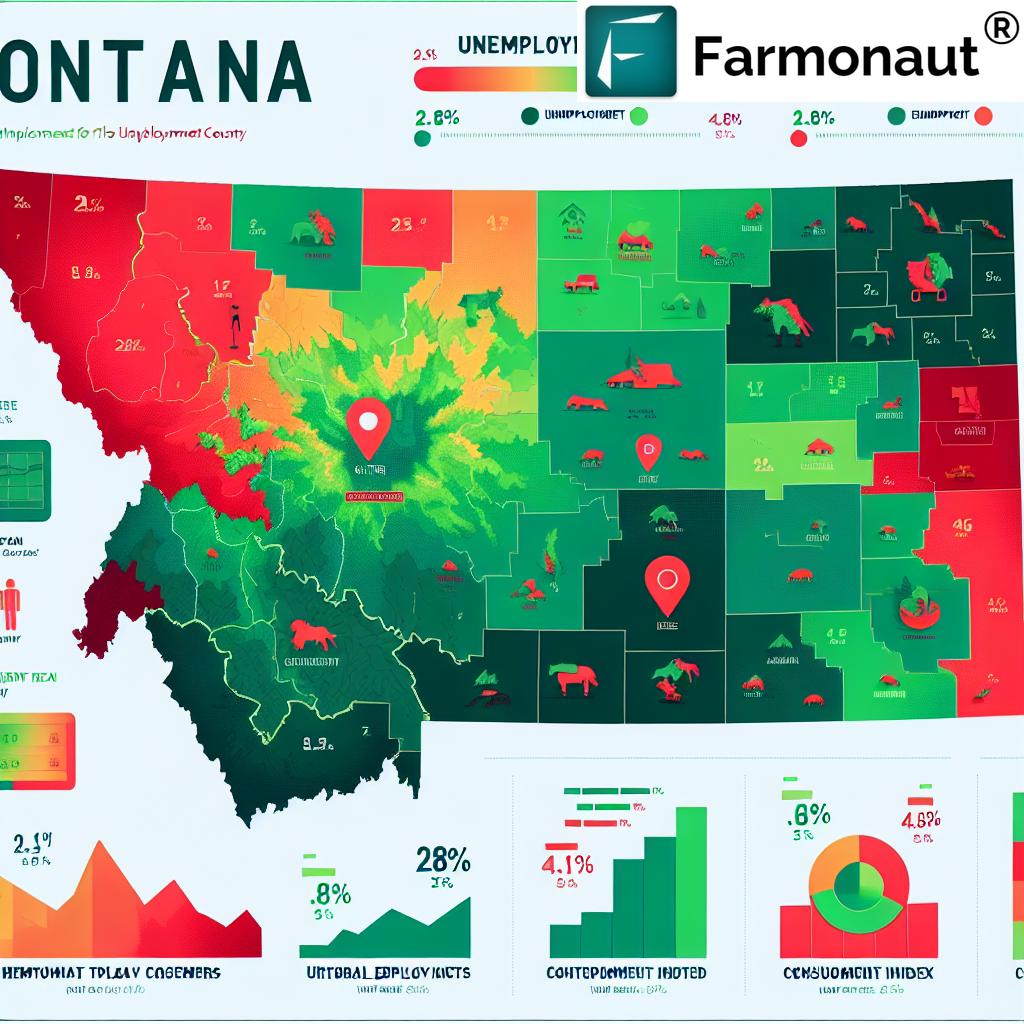Montana’s Unemployment Rate Holds Steady at 2.8%: Economic Indicators and Job Market Trends
“Montana’s unemployment rate of 2.8% is 1.3 percentage points lower than the national average of 4.1%”
Welcome to our comprehensive analysis of Montana’s economic landscape, where we’ll delve into the state’s impressive unemployment rate, job market trends, and various economic indicators. As we explore the robust economy of the Treasure State, we’ll uncover insights that showcase Montana’s resilience and growth in the face of national economic challenges.
Montana’s Unemployment Rate: A Closer Look
Montana’s unemployment rate has held steady at 2.8% in February, marking an impressive 44-month streak of unemployment at or below 3.4%. This achievement is particularly noteworthy when compared to the national average of 4.1%. Let’s break down what this means for the state’s economy and its residents.
- Montana unemployment rate: 2.8%
- National unemployment rate: 4.1%
- Difference: 1.3 percentage points lower
This significant difference highlights Montana’s strong economic performance and its ability to provide job opportunities for its residents. Governor Greg Gianforte emphasized the state’s economic strength, noting, “Montana’s economy is strong, adding 3,000 new jobs and reaching a record high labor force of nearly 580,000 in 2024.”

Factors Contributing to Montana’s Economic Success
Several factors have contributed to Montana’s economic success and low unemployment rate. Let’s explore some of the key elements driving this positive trend:
- Tax Cuts: Recent tax cuts implemented by the state government have played a significant role in stimulating economic growth and job creation.
- Strong Work Ethic: Montana’s workforce is known for its strong work ethic, which attracts businesses and fosters a productive economic environment.
- Diverse Employment Sectors: The state’s economy benefits from a diverse range of employment sectors, including agriculture, tourism, and technology.
- Natural Resources: Montana’s abundant natural resources contribute to industries such as mining, forestry, and energy production.
These factors have collectively contributed to Montana’s robust job market and low unemployment rate. However, it’s essential to examine the state’s economic indicators in more detail to gain a comprehensive understanding of its economic health.
Montana’s Labor Force Statistics
Montana’s labor force has reached a record high of nearly 580,000 in 2024. This milestone reflects the state’s growing economy and the increasing number of residents participating in the workforce. Let’s break down some key labor force statistics:
- Total labor force: Nearly 580,000
- Employment growth: 3,000 new jobs added
- Labor force participation rate: Consistently high
These numbers indicate a healthy job market with ample opportunities for Montana residents. The consistent growth in the labor force suggests that more people are entering the job market, either as new graduates or as previously discouraged workers re-entering the workforce.
Employment Sectors in Montana
Montana’s economy is diverse, with various sectors contributing to its overall economic health. While the state has seen growth in many areas, some sectors have experienced recent changes. Let’s examine the key employment sectors and their current trends:
- Agriculture: A cornerstone of Montana’s economy, employing a significant portion of the workforce.
- Construction: Recently experienced a decline in payroll jobs.
- Government: Also saw a decrease in employment numbers.
- Tourism: Continues to be a vital sector, particularly during summer months.
- Technology: An emerging sector with potential for future growth.
Despite the recent declines in construction and government sectors, Montana’s overall employment landscape remains strong. The state’s ability to maintain a low unemployment rate speaks to its economic resilience and adaptability.
Consumer Price Index and Inflation in Montana
Understanding the Consumer Price Index (CPI) and inflation rates is crucial for gauging the overall economic health of Montana. Let’s examine the recent trends in these economic indicators:
- Consumer Price Index for All Urban Consumers (CPI-U): Increased by 0.2% in February
- Shelter costs: Rose by 0.3%
- All-items index: Increased by 2.8% over the past year
- Core inflation (excluding food and energy): Rose by 3.1%
These figures suggest a moderate increase in prices, with shelter costs being a significant contributor to the overall rise in the CPI-U. The core inflation rate of 3.1% indicates that price pressures are present in the economy, but not at alarming levels.
For businesses and individuals looking to monitor and reduce their environmental impact, Farmonaut’s carbon footprinting tool can be incredibly useful. This innovative solution helps track and manage carbon emissions, contributing to more sustainable practices across various industries in Montana.
Unemployment Rates by County: A Detailed Analysis
Montana’s low unemployment rate is an average across the state, but it’s essential to examine the variations between counties to understand the economic landscape fully. Let’s look at some of the counties with unemployment rates below the national average:
- Gallatin County: 2.3%
- Lewis and Clark County: 3.1%
- Missoula County: 3.2%
- Cascade County: 3.3%
- Yellowstone County: 3.3%
- Silver Bow County: 3.7%
- Flathead County: 3.9%
These counties represent some of Montana’s more populous areas and economic centers. Their low unemployment rates contribute significantly to the state’s overall economic success.
| County Name | Unemployment Rate (%) | Rank in State |
|---|---|---|
| Carter County | 1.6 | 1 |
| Gallatin County | 2.3 | 2 |
| Lewis and Clark County | 3.1 | 3 |
| Missoula County | 3.2 | 4 |
| Cascade County | 3.3 | 5 |
| Yellowstone County | 3.3 | 6 |
| Silver Bow County | 3.7 | 7 |
| Flathead County | 3.9 | 8 |
| Sanders County | 7.4 | 56 |
“Carter County has the lowest unemployment rate in Montana, while Sanders County has the highest.”
It’s important to note the stark contrast between the lowest and highest unemployment rates in the state:
- Lowest: Carter County at 1.6%
- Highest: Sanders County at 7.4%
This disparity highlights the economic variations within Montana and underscores the need for targeted economic development strategies in areas with higher unemployment rates.
Montana’s Economic Growth: A Closer Look
Montana’s economic growth has been steady and impressive, contributing to its low unemployment rate and strong labor market. Let’s examine some of the key factors driving this growth:
- Entrepreneurship: Montana has a thriving startup ecosystem, particularly in tech hubs like Bozeman.
- Natural Resource Management: Sustainable use of the state’s abundant natural resources continues to drive economic growth.
- Tourism: Montana’s natural beauty attracts millions of visitors annually, boosting the service and hospitality sectors.
- Agricultural Innovation: The adoption of new technologies in farming and ranching has increased productivity and sustainability.
Speaking of agricultural innovation, Farmonaut’s crop plantation and forest advisory services offer valuable insights for Montana’s farmers and forest managers. These tools can help optimize crop yields and manage forest resources more effectively, contributing to the state’s agricultural productivity.
Impact of Montana’s Low Unemployment Rate
The consistently low unemployment rate in Montana has several positive impacts on the state’s economy and its residents:
- Higher Wages: With a tight labor market, employers often offer higher wages to attract and retain talent.
- Increased Consumer Spending: More employed individuals lead to higher consumer spending, boosting local businesses.
- Reduced Poverty: Lower unemployment typically correlates with reduced poverty rates.
- Attraction of New Businesses: A strong labor market can attract new businesses to the state, further stimulating economic growth.
These positive impacts contribute to a virtuous cycle of economic growth and prosperity for Montana residents.
Challenges and Opportunities in Montana’s Job Market
Despite the overall positive economic indicators, Montana’s job market faces some challenges and opportunities:
- Skill Gaps: Some industries may face difficulties finding workers with specific skill sets.
- Rural-Urban Divide: Economic opportunities may not be evenly distributed between urban and rural areas.
- Seasonal Employment: Tourism and agricultural sectors can lead to fluctuations in employment throughout the year.
- Workforce Development: Continued investment in education and training programs is crucial for maintaining a skilled workforce.
Addressing these challenges while capitalizing on opportunities will be key to maintaining Montana’s strong economic performance.
For businesses looking to optimize their operations, Farmonaut’s fleet management solutions can help improve efficiency and reduce costs, particularly in industries that rely heavily on transportation and logistics.
Montana’s Economic Indicators: A Comprehensive Overview
To fully understand Montana’s economic health, it’s essential to examine a range of economic indicators beyond just the unemployment rate. Let’s review some key metrics:
- Gross Domestic Product (GDP) Growth: Montana’s GDP has shown consistent growth in recent years.
- Per Capita Income: The state has seen steady increases in per capita income, reflecting improved living standards.
- Housing Market: Montana’s housing market remains strong, with increasing home values in many areas.
- Business Formation: The rate of new business formations indicates a healthy entrepreneurial environment.
These indicators, combined with the low unemployment rate, paint a picture of a robust and growing economy in Montana.
The Role of Technology in Montana’s Economic Growth
Technology plays an increasingly important role in Montana’s economic growth, particularly in sectors like agriculture, energy, and tourism. Innovations in these areas are helping to drive productivity and create new job opportunities.
In the agricultural sector, for example, Farmonaut’s crop loan and insurance services are helping farmers access crucial financial support and manage risk more effectively. This technology-driven approach is contributing to the resilience and growth of Montana’s agricultural industry.
Future Outlook for Montana’s Economy
Looking ahead, Montana’s economic future appears bright, with several factors contributing to continued growth and low unemployment:
- Diversification: Ongoing efforts to diversify the economy will help insulate it from sector-specific downturns.
- Technological Adoption: Increased adoption of advanced technologies across industries will drive productivity and create new job opportunities.
- Sustainable Practices: Focus on sustainable practices in industries like agriculture and energy will ensure long-term economic viability.
- Education and Workforce Development: Continued investment in education and training will help maintain a skilled workforce.
These factors, combined with Montana’s strong work ethic and favorable business environment, suggest that the state is well-positioned for continued economic success.

Conclusion: Montana’s Economic Resilience and Growth
Montana’s steady unemployment rate of 2.8%, significantly lower than the national average, is a testament to the state’s economic resilience and growth. The combination of a strong work ethic, recent tax cuts, and a diverse economy has positioned Montana as a leader in job creation and economic stability.
From the lowest unemployment rate in Carter County to the highest in Sanders County, Montana’s economic landscape showcases both achievements and areas for improvement. The state’s record-high labor force of nearly 580,000 in 2024 further underscores its economic vitality.
As Montana continues to navigate challenges such as inflation and sector-specific employment fluctuations, its strong foundation and forward-looking policies suggest a promising economic future. By leveraging its natural resources, embracing technological innovations, and fostering a business-friendly environment, Montana is well-equipped to maintain its position as a state of economic opportunity and growth.
FAQ Section
Q: What is the current unemployment rate in Montana?
A: Montana’s unemployment rate is currently holding steady at 2.8%.
Q: How does Montana’s unemployment rate compare to the national average?
A: Montana’s unemployment rate of 2.8% is significantly lower than the national average of 4.1%.
Q: Which county in Montana has the lowest unemployment rate?
A: Carter County has the lowest unemployment rate in Montana at 1.6%.
Q: Which county in Montana has the highest unemployment rate?
A: Sanders County has the highest unemployment rate in Montana at 7.4%.
Q: What factors contribute to Montana’s low unemployment rate?
A: Factors contributing to Montana’s low unemployment rate include recent tax cuts, a strong work ethic, diverse employment sectors, and abundant natural resources.
Q: How many new jobs has Montana added recently?
A: Montana has added 3,000 new jobs, reaching a record high labor force of nearly 580,000 in 2024.
Q: What is the Consumer Price Index (CPI) trend in Montana?
A: The Consumer Price Index for All Urban Consumers (CPI-U) in Montana increased by 0.2% in February, with a 2.8% increase over the past year.
Q: How does Montana’s economy compare to other states?
A: Montana’s economy is performing well compared to many other states, with its unemployment rate significantly lower than the national average and consistent economic growth.
Farmonaut Subscriptions
Earn With Farmonaut
Earn 20% recurring commission with Farmonaut’s affiliate program by sharing your promo code and helping farmers save 10%. Onboard 10 Elite farmers monthly to earn a minimum of $148,000 annually—start now and grow your income!
Learn More About Farmonaut’s Affiliate Program
Farmonaut Apps and Services
Explore Farmonaut’s range of innovative agricultural solutions:
For developers interested in integrating Farmonaut’s technology into their own applications, check out our API and API Developer Docs.
















